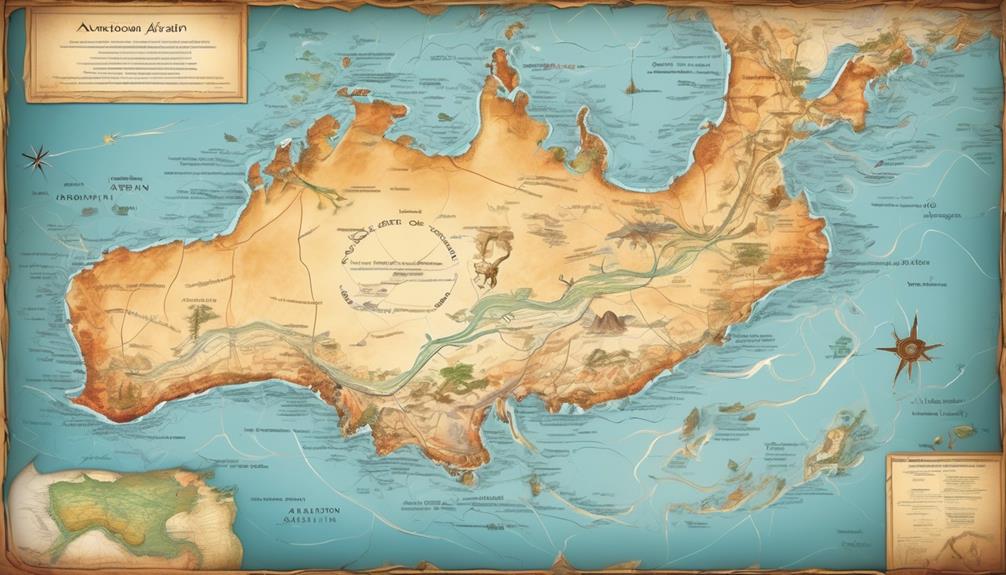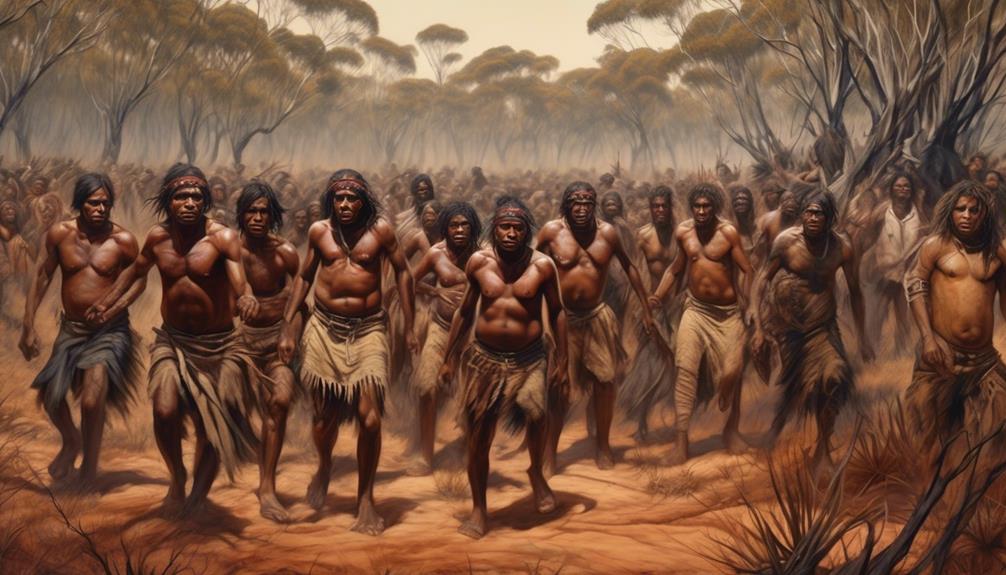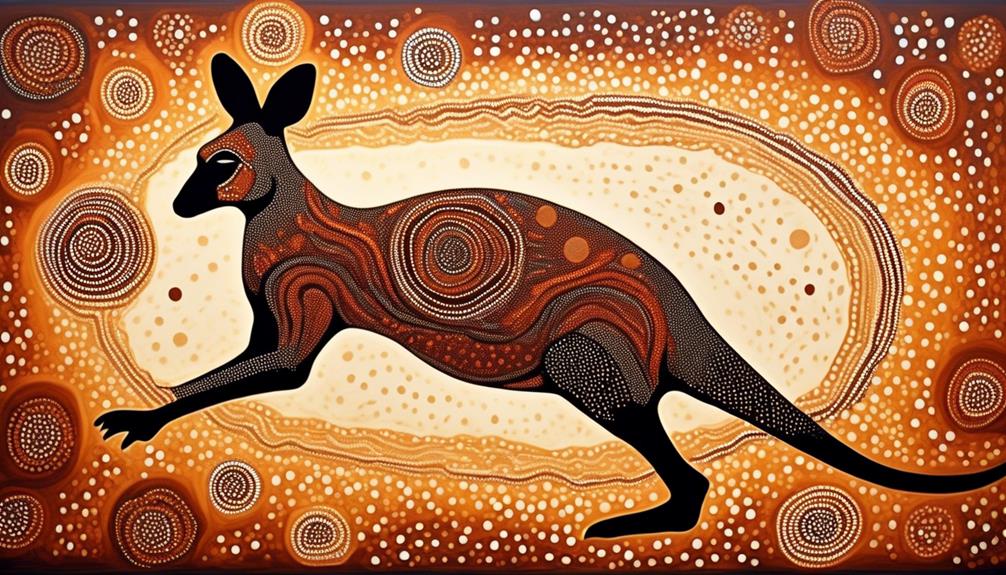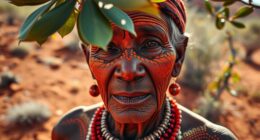Have you ever thought about the beginnings of Aboriginal Australians?
The question of their migration patterns and ancestral origins has intrigued researchers and scholars for decades. As we explore the various theories, archaeological findings, genetic studies, and environmental influences, it becomes evident that the story of Aboriginal Australian migration is a complex and fascinating one.
Join us as we unravel the clues and uncover the intriguing journey of their ancient ancestors, shedding light on their rich history and cultural heritage.
Key Takeaways
- Aboriginal Australians migrated from Southeast Asia around 50,000 years ago.
- They used watercraft for navigation and there is archaeological evidence of stone tools and artwork.
- Genetic studies indicate connections with Southeast Asian populations and reveal multiple waves of migration and diverse cultural backgrounds.
- Environmental and climate influences played a significant role in their adaptive strategies, cultural exchange, and resilience.
Early Indigenous Migration Theories
Early Indigenous migration theories propose various hypotheses regarding the initial peopling of the Australian continent by Aboriginal Australians. These theories are crucial in understanding the Indigenous settlement and cultural adaptations that took place in Australia.
One prominent theory suggests that the first Aboriginal Australians migrated from Southeast Asia around 50,000 years ago, possibly using watercraft to navigate through the islands. This theory is supported by archaeological evidence, such as stone tools and artwork, as well as genetic studies indicating connections between Aboriginal Australians and populations in Southeast Asia.
Another hypothesis posits that multiple waves of migration occurred, with different groups entering the continent at various times. This theory aligns with the diverse cultural and linguistic backgrounds observed among Aboriginal Australian communities. Additionally, it accounts for the regional variations in cultural practices and traditions found across the continent.
These early Indigenous migration theories not only shed light on the initial peopling of Australia but also provide insight into the cultural adaptations and diversity of Aboriginal Australians. Understanding these theories is essential for appreciating the rich heritage and history of Australia's Indigenous peoples.
Evidence From Archaeological Discoveries

Archaeological discoveries present compelling evidence supporting the migration origins of Aboriginal Australians, illuminating key aspects of their early settlement and cultural development. Through extensive excavations and analysis, researchers have uncovered crucial insights into the historical movements and adaptations of the Indigenous peoples of Australia.
- Archaeological findings: Excavations at sites such as Lake Mungo and Madjedbebe have unearthed ancient artifacts and remains, providing concrete evidence of human presence in Australia dating back over 65,000 years.
- Migration patterns: Studies of stone tools and genetic analysis have revealed intricate migration patterns, indicating multiple waves of migration from Southeast Asia to the Australian continent over millennia.
- Cultural adaptations: Examination of rock art, burial practices, and tools has shed light on the cultural adaptations and innovations of Aboriginal communities in response to diverse environments across the continent.
- Settlement patterns: The discovery of elaborate stone structures and evidence of semi-permanent settlements has offered valuable insights into the varied settlement patterns and social organization of early Aboriginal societies.
- Environmental interactions: Analysis of ancient plant and animal remains has provided valuable clues about the ways in which Aboriginal Australians interacted with and adapted to changing environments over time.
Genetic Studies and Ancestral Lineages
Genetic studies have provided crucial insights into the ancestral lineages and population movements of Aboriginal Australians, shedding light on the intricate genetic diversity and connections within their communities. Through the analysis of mitochondrial DNA and Y chromosome markers, researchers have been able to trace the deep ancestral lineages of Aboriginal Australians and understand the patterns of genetic diversity within different groups. These studies have revealed that there's significant genetic diversity among Aboriginal Australian populations, indicating complex historical population movements and interactions.
Population movement within Australia and between regions has also been inferred from genetic studies. By examining the distribution of specific genetic markers and analyzing the genetic variation among different Aboriginal groups, researchers have been able to reconstruct the migration routes and patterns of dispersal that shaped the genetic landscape of Aboriginal Australians. These genetic insights complement archaeological and anthropological evidence, providing a comprehensive understanding of the complex history of Aboriginal Australians and their connections to other populations.
Genetic studies continue to play a crucial role in unraveling the deep-rooted ancestral lineages and population movements of Aboriginal Australians, contributing to a more holistic understanding of their history and heritage.
Environmental and Climate Influences

The genetic studies on Aboriginal Australians have revealed significant insights into their ancestral lineages and population movements. Now, turning our focus to environmental and climate influences, we aim to examine the impact of these factors on the historical development of Aboriginal communities.
- Environmental Adaptation: The diverse Australian landscape, ranging from deserts to tropical rainforests, necessitated a wide range of adaptive strategies among Aboriginal communities.
- Resource Utilization: The varying climates and environments led to the development of specialized knowledge and practices for utilizing different resources, such as hunting, gathering, and land cultivation.
- Cultural Exchange: Environmental variations facilitated cultural exchange and interaction among different Aboriginal groups, influencing their traditions, languages, and social structures.
- Seasonal Patterns: Aboriginal communities developed intricate knowledge of seasonal patterns and environmental changes, shaping their nomadic or semi-nomadic lifestyles and resource management.
- Resilience and Innovation: Environmental challenges fostered resilience and innovation, leading to the development of unique technologies and social systems tailored to specific ecological niches.
Understanding the environmental and climate influences on Aboriginal communities provides valuable insights into their historical development, adaptive strategies, and cultural diversity. This enriches our appreciation of their enduring heritage.
Controversies and Ongoing Research
Despite the wealth of knowledge gained from previous studies, ongoing research into the history and migration patterns of Aboriginal Australians has sparked controversies and raised new questions about their ancestral origins.
Controversial theories surrounding the migration routes and timing of the first Aboriginal Australians continue to be at the forefront of academic debate. Some researchers argue for a single rapid movement of people into Australia around 50,000 years ago, while others propose multiple waves of migration over a longer period.
Additionally, the exploration of cultural connections between Aboriginal Australians and other ancient populations, such as the Denisovans and Papuans, has led to further complexities and discussions. The ongoing research has also brought into question the impact of cultural exchanges and interactions with neighboring populations, adding layers of complexity to the already intricate tapestry of Aboriginal Australian history.
As new evidence continues to emerge, it's clear that the controversies and ongoing research in this field will shape our understanding of the origins and migration patterns of Aboriginal Australians for years to come.
Frequently Asked Questions
What Are the Cultural Practices and Traditions of the Early Indigenous Migrants?
Cultural practices and traditional customs of early indigenous migrants reflect a deep connection to the land. Their rituals and ceremonies revolve around harmony with nature, with flora and fauna impacting every aspect of their daily lives. These practices are rooted in a profound understanding of the environment and sustainability, shaping their spiritual beliefs and social structures.
The preservation of these traditions is vital for understanding the rich history and heritage of Aboriginal Australians.
How Did the Migration of Aboriginal Australians Impact the Flora and Fauna of Australia?
The migration of Aboriginal Australians deeply impacted the flora and fauna of Australia, akin to a delicate ecosystem disturbed by a sudden quake. Their harmonious coexistence with nature for millennia fostered a balanced biodiversity.
The introduction of controlled fires and sustainable hunting practices shaped the landscape, fostering a rich variety of plant and animal life.
This delicate ecological balance is a testament to the profound influence of Aboriginal Australians on the Australian environment.
What Were the Social Structures and Governance Systems of the Early Indigenous Migrants?
We have found that the social structures of early indigenous migrants were built on complex social hierarchies, with governance systems that varied across different groups.
Cultural practices and traditional beliefs played a significant role in shaping these structures, often influencing leadership and decision-making.
The understanding of these systems provides a deeper insight into the diverse and rich histories of Aboriginal Australian communities, and how they navigated their societal structures.
What Role Did Trade and Interaction With Other Cultures Play in the Migration of Aboriginal Australians?
Trade influences and cultural exchange significantly impacted the migration of Aboriginal Australians. Interactions with outsiders shaped migration patterns, leading to the exchange of goods, knowledge, and technologies. These interactions facilitated the spread of cultural practices and contributed to the diversity of Indigenous societies.
Trade networks also influenced settlement patterns and resource distribution, impacting the social and economic structures of early Indigenous communities.
How Have Modern Environmental Changes Affected the Understanding of Early Indigenous Migration Patterns?
Environmental changes have significantly impacted our understanding of early indigenous migration patterns. These changes have forced us to reevaluate traditional narratives and analyze how they've affected migration routes and settlement patterns.
Conclusion
In conclusion, the evidence from archaeological discoveries, genetic studies, and environmental influences all point to the fact that Aboriginal Australians migrated from Southeast Asia around 50,000 years ago.
This migration theory is supported by a wealth of scientific research and continues to be investigated through ongoing studies and discoveries.
The truth of this theory adds depth to our understanding of the rich and complex history of Indigenous Australians.
Mary is a passionate writer who brings creativity and a fresh perspective to our team. Her words have the power to captivate and inspire, making her an essential contributor to our content. Mary’s commitment to storytelling and dedication to promoting Indigenous culture ensures that her work touches the hearts of our readers. We’re fortunate to have her as part of our team.










